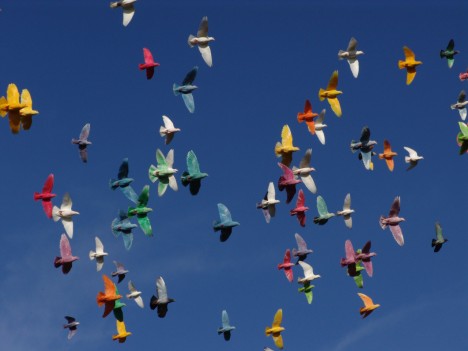Monday, June 20th, 2011

There’s no place like home – especially if you’re a pigeon. Molokai Rainbows, Clay Adachi’s business of releasing multi-colored pigeons for events around Molokai, brings smiles to awed onlookers as the birds swirl in unison overhead before heading straight home to their roomy pens in Adachi’s backyard.
“Ninety-nine point nine percent of the time, they all come home,” he said.
Referred to as homing pigeons, racing pigeons (a sport practiced around the world) and carrier pigeons, the species have been used for thousands of years to carry messages hundreds of miles before mail service or the Internet. While the navigation methods pigeons use are highly debated, many scientists believe the birds use the earth’s magnetic field to find their way. Adachi’s birds can fly home all the way from Maui, where he occasionally releases them for training.
Raising birds has been a lifelong passion for Adachi. He developed a special fondness for white pigeons after he was given a pair when he was young. Now, he owns about 150 birds, something he got back into, he said, more than 15 years ago. After that, “I figured I’d rent them out to pay for their own feed,” Adachi explained.
A Day in the Life
.JPG)
He keeps the food coloring mixtures in mayonnaise jars in the fridge, and warms it up before pouring the liquid into a small pan.
“I dip the birds right in and throw them up on the roof to dry,” he chuckled.
It’s important that the dye can dry completely before Adachi puts the pigeons in their boxes to transport for release. If the food coloring is still wet, it will rub onto other birds for some unplanned rainbow colors.
The food coloring is harmless to the health of the birds, though it does pose one challenge: they can’t fly in the rain. The dye, Adachi explained, absorbs water so it inhibits the birds’ ability to fly under wet conditions because their feathers don’t repel water as well.
He began dying the birds’ wings years ago as a way to identify them. That’s how he got the idea to color some of the birds for various occasions – like using red, white and blue birds for veterans’ events.
EventsLarry Helm, commander of Veterans Caring for Veterans, said releasing the patriotic-themed pigeons at veterans’ events is a way of “respecting the veterans to the max.”
“Veterans feel special that they can light up sky with all these colored pigeons in honor of those who have served,” said Helm. “The response has always been ‘wow.’”
Adachi, an Air Force veteran himself, said he’s been releasing birds for the veterans for years, free of charge.
Normally, his rates vary with location, from $75 around Kaunakakai, up to $200 on the island’s east and west ends, according to Adachi.
He flies the Molokai Rainbows at birthdays, weddings, funerals – “anything and everything.” He said he gets a lot of inquiries, and one comes through every couple of months. Since the birds can’t fly in the rain, Adachi said he has to play it by ear, and can offer refunds if the weather falls through.
“We’d love to grow this into more of a business,” Diane Adachi said.
If you’d like to book Molokai Rainbows to add a special touch to your next event, call Adachi at 553-5580 or email dcmolokai@hotmail.com.







_0.jpg)
_0.jpg)

.JPG)
.JPG)
.JPG)
by Val Bloy (Medium).JPG)
by Val Bloy (Medium).JPG)



